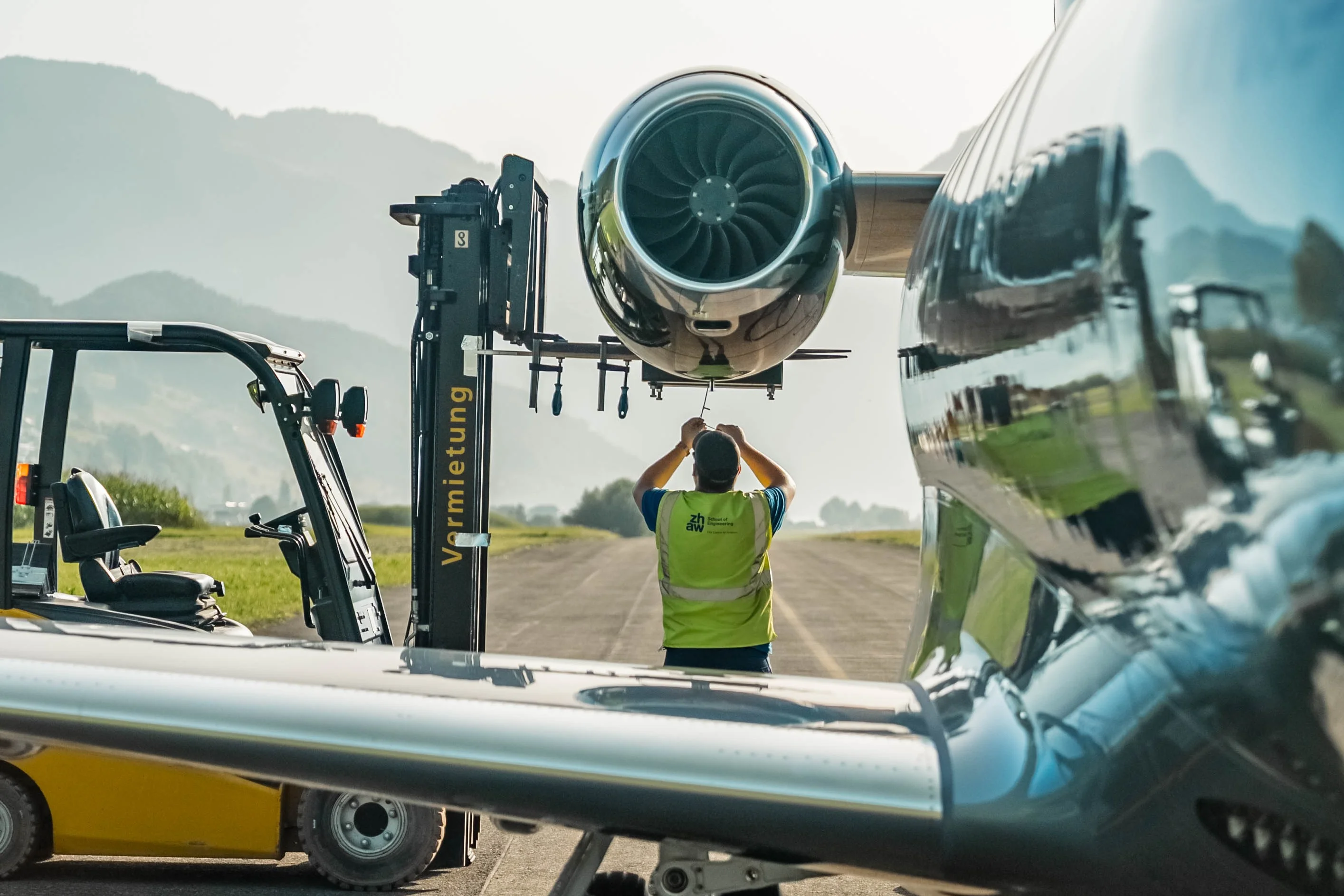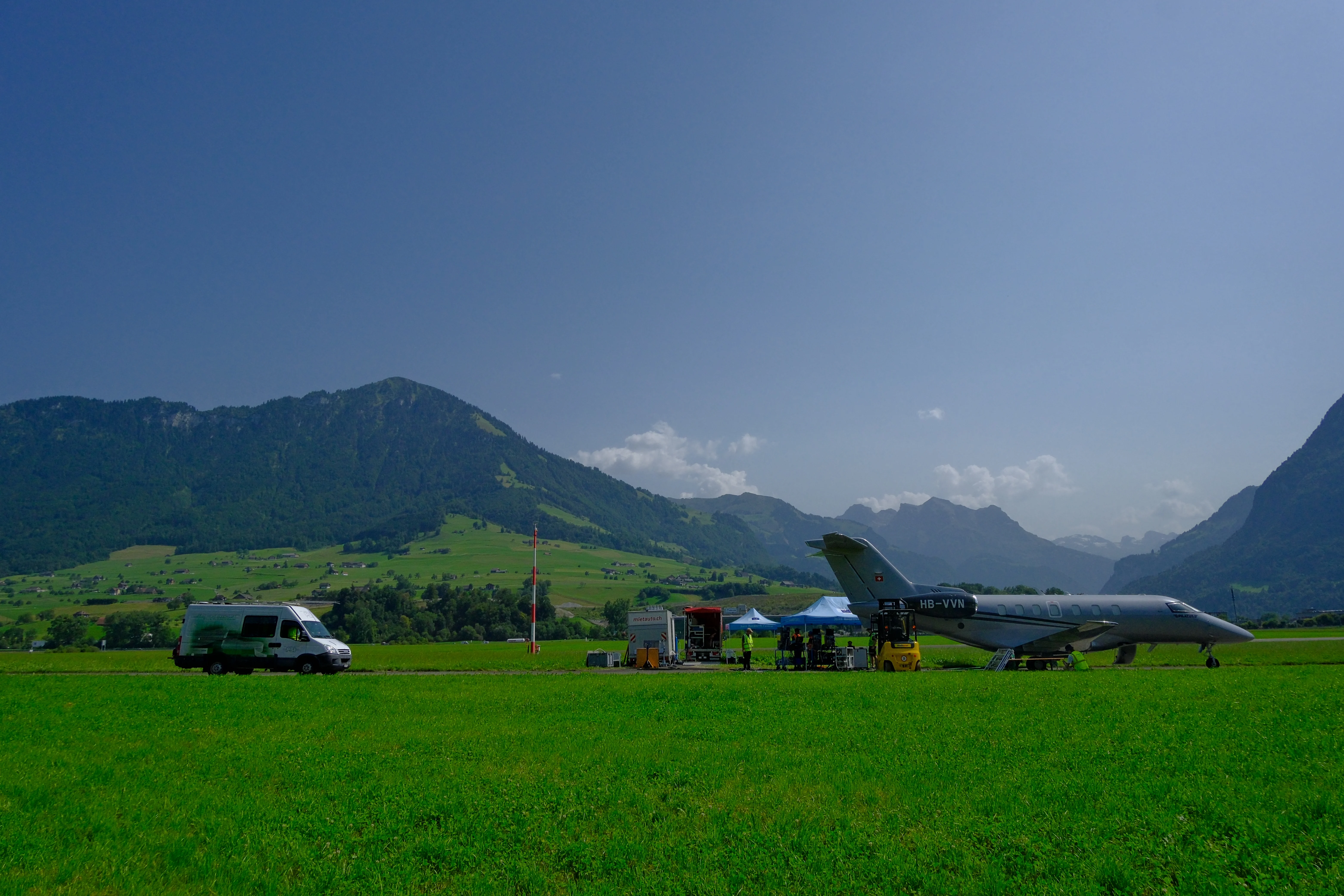ZHAW research shows: Sustainable fuels significantly reduce soot emissions
An interdisciplinary team at ZHAW, together with partners from research and industry, investigated the emissions of a Pilatus PC-24 business jet. First results confirm the great potential of sustainable aviation fuels for a more environmentally friendly aviation sector.

In a large-scale measurement campaign, the Centre for Aviation and the Institute of Chemistry and Biotechnology at ZHAW, together with the Paul Scherrer Institute, the Joint Research Center of the European Commission and Pilatus Aircraft, analyzed the engine emissions of a PC-24 when using sustainable aviation fuels (SAF).
The investigations focused on three core areas: testing new measurement technology, studying the aging of aerosol particles in the aircraft exhaust plume at high ambient temperatures of 30°C and conducting a detailed analysis of engine soot emissions. The first evaluations, presented in September at the European Aerosol Conference, are extremely promising: the use of SAF leads to a significant reduction in emitted soot particles.
Ambitious project goals
The measurements are part of the ADVISAR project, supported by the Federal Office of Civil Aviation (FOCA). The project pursues further ambitious goals: By December 2025, a new measurement facility will be established at the engine test stand of SR Technics at Zurich Airport. As early as October 2025, investigations will also begin on the effects of engine exhaust gases on human lung cells. Another measurement campaign with the Pilatus PC-24 is planned for early 2026, in order to further deepen the findings under colder conditions.
Three questions for the project lead, Dr. Tobias Schripp
How exactly did the measurement campaign proceed?
T.S.: The campaign was a considerable logistical and technical challenge, requiring meticulous planning. We had only one week for the complete setup, dismantling, and the measurements themselves – under demanding field conditions on a taxiway at Buochs Airport.
First, we positioned our measurement probe directly behind the engine of the Pilatus PC-24 in order to capture emissions of particles (soot) and gases across the entire thrust spectrum. At the same time, the measurement vehicle “MOSQUITA” of our partner, the Paul Scherrer Institute, analyzed the exhaust plume at some distance. This two-point approach is crucial, as it allows us to study the aging processes of emissions in the atmosphere.
We carried out this entire cycle first with conventional fossil kerosene as a reference, and then repeated it with a sustainable aviation fuel (SAF).
It was an incredibly intensive week for the entire team, but the effort was worth it. The high quality of the collected data is the best reward for these efforts.
How and why do the results of SAF differ from conventional aviation fuels?
T.S.: The biggest difference lies in the “cleanliness” of the fuel. Conventional kerosene can be seen as a complex natural product that inherently contains substances which, during combustion, lead to soot – above all the so-called aromatics. The blended sustainable fuel (SAF) is purer and reduces precisely those components that form soot.
From a scientific perspective, it was crucial for us not only to determine whether emissions decrease, but also how they decrease. A reduction of soot mass alone, accompanied by an increase in the number of smaller particles, would be counterproductive. Imagine it this way: there is a difference between removing a large stone and smashing it into hundreds of small pebbles. The latter could even be more harmful. However, our measurements clearly showed that both decrease: less mass and fewer particles without a change in size distribution.
What do the results mean for the further progress of the project?
T.S.: The results not only confirm our research approaches, but also open up very concrete next steps. We were able to obtain highly significant data on the release of organic emissions, such as those originating from engine oils. This is of enormous importance, since these emissions are expected to be included in future aviation emissions regulations, and there is still very little reliable data from real flight operations. Our measurements create an important knowledge base here.
For the project this means two things: Firstly, we will deepen the research with the follow-up project “JETSTREAM” – the application has already been submitted. Secondly, we are planning a repetition of the measurement campaign under varied external conditions in order to further strengthen our findings.
This success was only possible thanks to the excellent teamwork and cooperation with our external partners. In particular, the straightforward and professional support from Pilatus made this complex field measurement campaign possible in the first place, for which we are very grateful.

